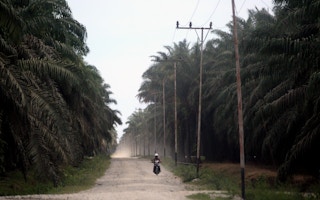High costs and a lack of funding stand in the way of Indonesia achieving its target for the restoration of degraded peatland across the country, a new study says.
The government in 2016 embarked on a program to restore 20,000 square kilometers (7,720 square miles) of degraded peat forest by 2020. The cost for this undertaking, according to a recent study by researchers at the University of Queensland, Australia, will likely exceed $4.6 billion.
To date, however, the Indonesian government has budgeted just $200 million for the initiative, according to the study, and the results are telling: only 2,000 square kilometers (772 square miles) of peatland, or 10 per cent of the total, had been rewetted by the end of 2017.
That funding includes 34 million Norwegian krone ($4.4 million) from the Norwegian government and $134.6 million from the U.S., U.K., Japan, Germany and the Netherlands. For its part, the Indonesian government initially allocated the equivalent of $60.5 million from its 2017 spending budget.
The $200 million figure cited in the study, though, used the lowest cost projections available and did not account for the subsequent slashing of Indonesia’s contribution by half, as part of wider cost-cutting measures by the Ministry of Finance.
Preventing fires
The peat-restoration initiative was born out of the need to prevent the kinds of land and forest fires that devastated huge swaths of the country in 2015. While such fires are an annual occurrence linked to the clearing of land for commercial agriculture, the burning and haze in 2015 were exacerbated by the draining of peat forests, which render the permanently moist peat soil dry and highly combustible.
Peat forests are globally significant both for their ability to store carbon dioxide and for their biodiversity. In Indonesia, peatlands in Sumatra are home to critically endangered species such as orangutans, rhinos and tigers.
“Restoring peat will, therefore, be critical not only for Indonesia to achieve its emission reduction target, but also to provide habitat for these species,” Amanda Hansson, a co-author of the new study, told Mongabay.
To protect these landscapes, President Joko “Jokowi” Widodo in 2016 established the Peatland Restoration Agency, or BRG.
Hansson and her team used data from the BRG to examine the case of peatland restoration in Sumatra, Papua and Kalimantan, the Indonesian portion of the island of Borneo. They classified peat forests based on their fire, logging and drainage histories, as well as their current hydrological conditions.
They found that peat areas with low-intensity fires were more easily restored than those that had experienced high-intensity fires, with the former showing greater signs of unassisted recovery compared to the latter.
But the biggest determinant of the total cost of restoration, the researchers found, is the width of the canals dug to drain the peat soil in preparation for planting. The wider the canals, typically associated with oil palm plantations, the more difficult, and more expensive, it is to restore the peat areas, Hansson said.
“I was particularly surprised by the high cost associated with restoring wide canals, which can reach up to $23,500 per hectare,” or about $9,500 per acre, she said. “Restoring peat which has been drained using large-scale canals can quickly become very expensive.”
Restoring or rewetting small-scale agricultural landscapes, however, is relatively inexpensive, starting at around $400 per hectare. These areas typically have much smaller canals that can be dammed much more cheaply.
Funding gap
Peat areas that have been drained and burned for commercial use make up the bulk of BRG’s working area, driving the potential cost of the entire endeavor to $4.6 billion, the study estimated.
The stark difference between the actual funding allocated and the money required to successfully restore the targeted 20,000 square kilometers of peatland leaves Indonesia facing a difficult decision, Hansson said.
“This shortfall means Indonesia will have to choose between using best-practice methods in smaller areas or using cheaper and potentially ineffective restoration methods to reinstate larger areas of degraded peat forest,” she said.
The government, she added, would have to address the shortfall if it wanted to meet the target.
“Attracting global funding will be essential for Indonesia in realizing this target, and developing a cost estimate may help in highlighting the need for international support in this process,” Hansson said.
When asked about the findings, BRG head Nazir Foead said he had not yet read the study but would look into it.
This story was published with permission from Mongabay.com. Read the full story.










